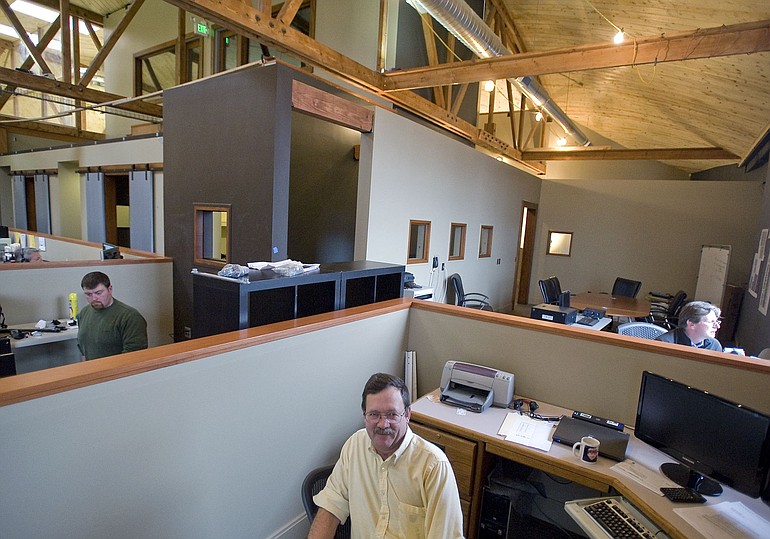Company: Sigma Design Inc.
o History: Founded in 1994. Bill Huseby joined Sigma in 1997 and purchased the company in 2000.
o Location: 1714 Broadway, Vancouver.
o Business: Product design and development services in mechanical and electrical engineering, industrial design and fabrication.
o Employees: 35, including three in Singapore office.
Forget about the recession that, for Sigma Design, never happened.
Bill Huseby, owner of the downtown Vancouver product design and engineering firm, is facing the welcome challenge of managing his company’s rapid growth.
Sigma has expanded from just 10 employees in 2006 to 35 today, and it has set a target to increase revenues and profits by 20 percent per year for the next decade. Huseby, 51, has set another goal that’s impossible to quantify and probably much tougher to achieve: He wants Sigma to remain a fun place to work no matter how big it becomes.
Company: Sigma Design Inc.
o History: Founded in 1994. Bill Huseby joined Sigma in 1997 and purchased the company in 2000.
o Location: 1714 Broadway, Vancouver.
o Business: Product design and development services in mechanical and electrical engineering, industrial design and fabrication.
o Employees: 35, including three in Singapore office.
A former engineer and manager at Hewlett-Packard’s Vancouver printing division, Huseby has gone to unusual lengths to nurture a company culture that values fun, energy, and edginess. The company’s new headquarters building, opened in February in a former auto repair shop, reflects those values with a signature rock-climbing wall and a foosball table where employees can blow off steam. The exterior walls are of corrugated steel, interior floors are colored concrete, and the work area has an open design to invite collaboration.
When it comes to prioritizing family and personal well-being, Huseby leads by example. He takes time off to coach Little League and escape the office for sailboat races across the Pacific, once with his wife, Becky. (He won three of the seven races he’s entered). When he’s away, he turns off the cell phone and delegates management to Vice President Doug Hill.
“I think you can still have fun as you grow,” says Huseby, who works at an open desk rather than a private office. “I am testing that theory.”
Management experts say that periods of rapid growth can be challenging times for small companies trying to build and nurture strong cultures. Even huge corporations can maintain strong cultures that propel their success — Hewlett-Packard’s one-time collaborative hiring and decision-making process known as the HP Way comes to mind — but the company’s charismatic leader needs to have a strategy for instilling that culture in new employees, says Joe Cote, marketing professor at Washington State University Vancouver.
“Culture can be a significant motivator — people who like where they work tend to perform much better,” Cote says. “But you have to have systems to get them acculturated. It takes time to build a culture.”
Something missing
In 2006, Huseby gathered Sigma’s 10 employees to discuss the company’s future. He had owned the company for six years. Work was steady, Huseby recalled in an article he wrote for a recent company newsletter, but something was missing: a passion for growth.
Sigma wanted to raise its ambitions but not at the expense of employees’ job satisfaction. It set ambitious targets for increasing revenues and profits over 10 years.
“But more importantly,” Huseby wrote in the newsletter that was filled with biographies of new employees, “we committed to grow the fun.”
Huseby says he never focused much on marketing or even worrying about his competition. Instead, he focused on building repeat business from satisfied customers. The recession created new opportunities as companies downsized their in-house engineering staff and turned to outside firms for expertise. Huseby also pushed and increased the range of services Sigma could offer to clients, from concept to design to production.
“I get a lot of unsolicited advice that we should specialize,” he says. “I don’t agree.”
“The comparison I use that people can understand is that if we were building a house, we would be the architect, contractor, and framer. We can do it all.”
That mantra puts Sigma in the worlds of sporting goods, medical equipment, computer printers, bicycle transmissions, consumer electronics, and countless other fields. The company works on hundreds of projects in a year, and probably has more than 100 in various stages of development right now, he says. Most are fabricated on one of two production machines right at Sigma’s headquarters.
“Adaptability is one of our core values,” Huseby says. “Opportunity comes to us, and we take advantage of it.”
For Sigma employees, the diverse technical challenges in their daily work create the fun that keeps them motivated.
“By far the biggest fun for me is the variety of job challenges, says Ben Mergen, 35, a mechanical engineer at Sigma for 10 years. “All the hats you get to wear — working at the desk, building, testing, training, flying to Asia to set up a tool, trying to figure out how electrical engineering works — it helps keep me on my toes.”
The company’s growth has led to increased workloads recently, and employees say fun is harder to find in the short term. Still, says Mark Schoening, recently hired as director of industrial design after years of working with Sigma Design: “My perspective is relatively fresh, but these guys are really fun. Everybody’s looking for a reason to laugh.”
Open house planned
Sigma operated for years out of two buildings on Broadway at 15th Street that became increasingly crowded and disjointed.
Last month, the company moved two blocks north on Broadway, into the former Don Lorentz auto repair shop, which it will showcase in an invitation-only open house this week.
Huseby designed the new space to reflect his own business values, taking advice from his employees and even his own mother. He realized his professional skills lent themselves easily to leading a building remodel.
“When you design a product, you have needs, you make trade-offs, you have a schedule. It’s the same thing,” he says. Besides, he adds, “I really had a vision for it.”
That vision focused heavily on allowing workers to easily collaborate across specialties, from design to fabrication; allowing lots of light in large windows and skylights through a loft ceiling; making room for the foosball table, showers for bike riders and joggers, and the iconic rock wall. That still-unfinished wall behind the desk of office administrator Melisa McVicker sends a message that Sigma operates with an adventurous attitude.
Huseby says he hopes the building will impress clients, but it’s really for his employees.
“This (building) is as much an investment in the people as it is in the business,” he says. “I want them to enjoy the idea of going to work.”
Mergen, the mechanical engineer, says working in the new building reminds him of the early days at Sigma.
“I could see everybody in the company, but as we grew bigger, we put up cubicles,” he said. “Now it’s open, and for me that makes a big difference. It feels like we’re all in it more together than we used to be.”
Huseby now finds himself drawing on the lessons, both good and bad, drawn from his time at Hewlett-Packard, from 1981 to 1997: Even with its time-consuming meetings and the company’s large bureaucracy, it was a model that worked, he says.
“The focus at HP was on getting stuff done,” he says. “When I started at HP, there were 250 people, and it was great fun.”




